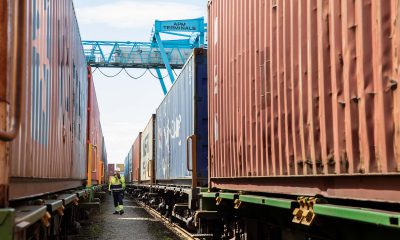DP World, a leading enabler of global trade, has completed the early stages of integration with TradeLens, a blockchain-based digital container logistics platform, jointly developed by A.P. Moller – Maersk and IBM.
The collaboration between DP World and the TradeLens platform will help accelerate the digitisation of global supply chains. DP World aims to connect all its 82 marine and inland container terminals, as well as feeder companies and logistics divisions with TradeLens. In 2019 DP World’s terminals handled 71.2 million TEU (twenty-foot equivalent units) containers from around 70,000 vessels.
TradeLens brings together data from the entire global supply chain ecosystem including shippers, port operators and shipping lines. It also aims to modernise manual and paper-based documents, replacing them with blockchain enabled digital solutions.
For DP World the data from its integration with TradeLens will improve operational efficiency with earlier visibility of container flows across multiple carriers.
Such visibility includes confirmation of the transport modality that follows the port stay for each container, which in heavy transhipment or rail ports enable better yard planning.
It will also expand the capabilities of DP World’s digital platforms created to move online the management of logistics. The DF Alliance, SeaRates, LandRates and AirRates enable shippers to move cargo to and from anywhere at the click of a mouse, across DP World’s network and beyond.
Sultan Ahmed Bin Sulayem, Group Chairman and Chief Executive Office of DP World said: “Our decision to team up with TradeLens is driven by our vision for intelligent logistics, reducing costs and creating value. DP World is working to deliver integrated supply chain solutions to cargo owners, backed by our global network of ports, terminals, economic zones and inland operations. By working with TradeLens we will accelerate the digitisation of global trade. Modernising the processes by which logistics operate is critical to building more robust and more efficient supply chains which will help economic development and generate more prosperity.”
TradeLens provides visibility across the entire supply chain, from booking to clearance to payments and is built on a wealth of input from the industry including direct integrations with more than 110 ports and terminals, 15+ customs authorities around the world and an increasing number of intermodal providers.
“It is very encouraging to see the continued adoption of the TradeLens platform among global logistics players as it helps global supply chain customers expand and explore the benefits of digital documentation flows. In turn, the broadened geographic scope of the platform provides new opportunities for TradeLens ecosystem participants to innovate and develop digital offerings on the platform,” said Vincent Clerc, CEO of Ocean and Logistics, A.P. Moller – Maersk.
“At its core the TradeLens business model is an open and neutral platform to spur collaboration and digitisation between all parties in the supply chain ecosystem. We are excited to welcome DP World and eagerly await the creation of new potential ways of working for shippers and consignees in global trade. With 4 of the 5 largest global port operators actively engaged with TradeLens, the coverage of the ecosystem continues to expand rapidly,” said Mike White, CEO GTD Solutions and Head of TradeLens
DP World has already connected Cochin Port (India) with the TradeLens platform via API technology. Plans to collaborate with other DP World business units, including the feeder line Unifeeder, have also been initiated.























